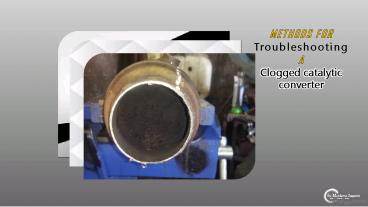Methods for Troubleshooting a Clogged Catalytic Converter - PowerPoint PPT Presentation
Title:
Methods for Troubleshooting a Clogged Catalytic Converter
Description:
The catalytic converter is an important part of the car that uses a catalyst to convert toxic by-products in the exhaust into harmless compounds. It needs to be always functioning and to achieve this, check for engine misfiring, record the performance and keep a track of the sounds from various parts of the car. See the below s and you will find the proper methods for troubleshooting a clogged catalytic converter. – PowerPoint PPT presentation
Number of Views:27
Title: Methods for Troubleshooting a Clogged Catalytic Converter
1
METHODS FOR Troubleshooting A Clogged
catalytic converter
2
A catalytic converter is a device that uses a
catalyst to convert toxic by-products in car
exhaust into harmless compounds.
3
In a catalytic converter, the catalyst is coated
onto a ceramic honeycomb or ceramic beads that
are housed in a muffler-like package attached to
the exhaust pipe.
4
The catalyst helps to convert carbon monoxide
into carbon dioxide, hydrocarbons into carbon
dioxide and water, and the nitrogen oxides back
into nitrogen and oxygen.
5
It is not a normal occurrence for a catalytic
converter to wear out as they are usually more
subject to external damage like road impact or
internal engine damage caused by overheating.
6
When you start troubleshooting a clogged
catalytic converter, it is advisable to check the
system to diagnose the problem.
7
Here is a list of methods for easy
troubleshooting a clogged catalytic converter in
your car.
8
Find the origin of the issue
9
While finding the cause of a clogged catalytic
converter, normally you get traced to a fuel
system problem.
10
A typical sign of this would be a restriction on
the behavior of the exhaust system caused by the
melting of catalyst materials inside the
converter.
11
The catalyst material can become contaminated
with silicon, which requires you to check the
body of the converter for signs of wear or
breakage.
12
Check for engine misfiring
13
The catalyst can overheat due to the misfiring,
or due to an excessively rich fuel mixture in the
engine.
14
When an extra rich fuel mixture occurs, raw fuel
enters into the catalytic converter and gets
ignited to result in melting of the catalyst
components.
15
In case, your car has a carburetor, you can test
the catalytic converter by removing the air
cleaner.
16
If you see signs of fuel vapor hovering over the
top of the carburetor, you can safely conclude
that the catalytic converter is clogged.
17
Check the performance
18
When there is a clogged catalytic converter, it
creates a back pressure which hampers the smooth
running of your engine and prevents it from
breathing.
19
This increase in back pressure could also cause
your engine to stall and making the car jerk or
feel that no fuel is reaching the engine when the
accelerator pedal is pressed.
20
The result is you will notice a serious
deterioration in fuel economy and overall
performance of the car.
21
Sounds
22
When the accelerator is applied and there is a
whistling sound, this indicates a restriction in
exhaust flow and a possible catalytic converter
problem.
23
There can be also rattling noises when your
vehicle is idling and that gets louder as you rev
the engine or drive at high speeds.
24
Sounds like this is a clear indicator of a
faulty converter and If it is clogged, you will
have to replace the entire unit because catalytic
converters cannot be repaired.
25
https//smiky.com/
Thank You!

